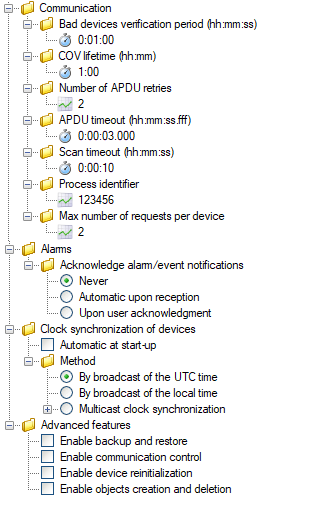BACnet settings
The Settings tab contains those settings associated with the general operation of the BACnet driver. The following screenshot was taken with the default configuration.
![]() Show picture
Show picture
- Communication
- Bad devices verification period - The period at which the device will be checked when trying to re-establish communication after a watchdog error has been detected. The default is 1 minute.
- COV lifetime - The validity period for COV messages from a device. The driver must subscribe to each device within this period or COV notification are no longer sent. The default is 1 hour.
- Number of APDU retries - The number of service requests retries to perform before returning an error. The default is 2.
- APDU timeout - The period allowed for a device to respond to a service request. The default is 3 seconds.
- Scan timeout - The period allowed for a reply when executing a network scan. The default is 10 seconds.
- Process identifier - The identity of PcVue, as a BACnet client, when configuring a notification. The default is 123456.
- Max number of requests per device - The maximum number of concurrent requests that can be made to a device. The default is 2.
- Alarms
- Acknowledge alarm/event notifications - The mechanism by which PcVue acknowledges the BACnet alarm and events (To Normal, To OffNormal & To Fault) generated by Notification Class objects.
- Never - PcVue never acknowledges notifications.
- Automatic upon reception - PcVues internal mechanisms automatically acknowledge all three alarm transitions as they are received.
- Upon user acknowledgement - To OffNormal notifications are acknowledged when the corresponding alarms are acknowledged by an operator (typically from an Alarm Viewer). To Normal and To Fault transitions are automatically acknowledged upon reception by PcVue's internal mechanisms.
- Acknowledge alarm/event notifications - The mechanism by which PcVue acknowledges the BACnet alarm and events (To Normal, To OffNormal & To Fault) generated by Notification Class objects.
- Clock synchronization of devices - The method used to synchronize the clock of BACnet devices.
- Automatic at start-up - Clock synchronization is performed automatically when either PcVue or network is (re)started.
- Methods
- By broadcast of the UTC time - Use UTC (Universal Coordinated Time) in the time synchronization broadcast.
- By broadcast of the local time - Use the computers local time in the time synchronization broadcast.
- Multicast clock synchronization - Distribute time synchronization by a multicast of the local time.
- Clock synchronization period (min) - The interval, in minutes, at which TimeSynchronization and UTCTimeSynchronization requests are sent. If set to 0, it is disabled. The default is 0.
- Align synchronization - If the Clock synchronization period is non 0, and is a factor of (divides without remainder) an hour or day, then the beginning of the interval is aligned to the hour or day. Not ticked by default.
- Synchronization offset - The offset, in minutes, from the beginning of the interval specified for time synchronization until the actual time synchronization requests are sent. The offset used is the value of Synchronization offset property modulo the value of Clock synchronization period property. The default is 0.
Example: If Synchronization Offset is 31 and Clock synchronization period is 30, the offset used is 1. Synchronization offset will have no effect if Align synchronization is disabled.
- Advanced features
- Enable backup and restore - Enable the backup and restore mechanism (BIBB DM-BR-A).
- Enable communication control - Enable the device communication control mechanism (BIBB DM-DCC-A).
- Enable device reinitialization - Enable the reinitialize device mechanism (BIBB DM-RD-A).
- Enable objects creation and deletion - Enable the object creation and deletion mechanism (BIBB DM-OCD-A).
